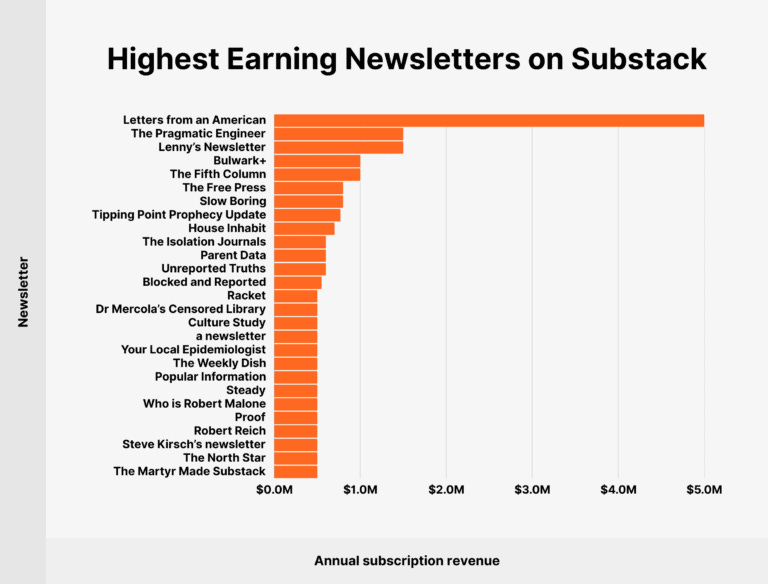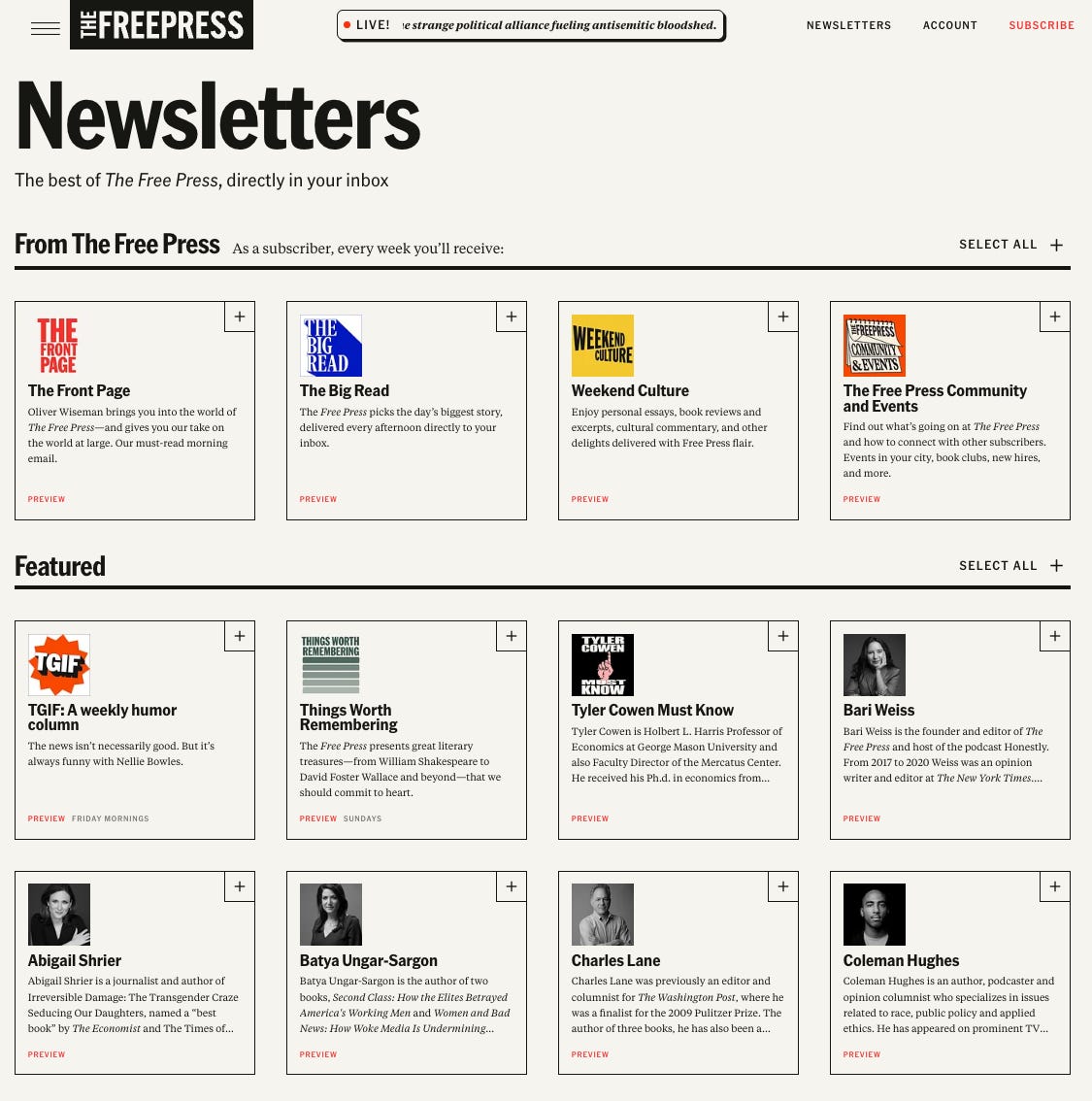What Substack Teaches Us About Media in 2025
Voice wins. Brand takes a backseat & the inbox still rules.
Substack is having a moment.
The newsletter/blogging/social platform added a million paying subscribers in late 2024 and Q1 2025, and is surely closing in on 6 million paying customers by now. It achieved nearly 100 million website visits in Decmeber 2024, and its cultural relevance is booming, thanks to so many big-name journalists leaving traditional media outlets to become Substackers.
If there’s one eternal rule of media, it’s that wherever attention heads, brands are sure to follow. And they are coming, en masse.
I obviously love the platform (Thanks for reading this!), but I’m not going to argue that your company should join the stampede. Most companies should probably proceed with more caution than they did when they wrangled the CEO and the intern into making a podcast in the COVID-era.
Rather, I see this Substack moment as a perfect lens to understand today’s media ecosystem: What’s working, what’s failing, and how the balance of power is changing.
That’s because Substack, and particularly its web and app environment, remains a relatively blank slate. There aren’t many strong incumbents or established best practices. It’s growing rapidly from a level-ish playing field, so the strategies that consumer and media companies are using as they move onto the platform say a lot about how media works in 2025.
From Newsletter Tool To Media Ecosystem
First, it’s apparent that Substack has outgrown its origins as a newsletter distribution platform. Substack is now a full-fledged media ecosystem that entices big-name journalists, and independent writers can build sustainable businesses. It has scale, community, and, for some, serious revenue.

There’s a fascinating cohort of new media brands, including The Free Press, The Ankler and The Bulwark, that are giving it a go entirely on Substack. Look at the homepages of these brands – this is not just a newsletter service.
Even traditional media are dipping their toes in, too, albeit much more slowly. NY Mag is there, as is Allure.
And why not? As Rachel Karten points out over at LinkInBio, “a Substack newsletter is something a lot of traditional email flows aren’t: fun.”
As is always the case, fashion is a first-mover. Clothing brands are setting up shop rapidly, leveraging a combination of paid collabs, bespoke partnerships like American Eagle’s Off the Cuff newsletter by Casey Lewis of After School fame, and founder-led newsletters with a highly personal touch.
Meanwhile, as part of its “No Ordinary Love” campaign, Hinge has launched a limited Substack series, which they’ll spin off into a book.
There’s a lot to digest in brand ecosystem at Substack, but several important meta (the concept not the company) themes stand out here.
The Byline is the Brand
First, virtually everything on Substack revolves around individual personality and voice. American Eagle leveraged an established celebrity writer in Casey Lewis. Hinge did the same, but with multiple writers all contributing to a single product, which they will eventually print as a book. Meanwhile Tory Burch is among several brands going founder-forward.
Media companies have the same strategy. The Free Press and The Ankler are largely roll-ups of individual newsletters into a single homepage. Subscribers can choose the main brand newsletter or newsletters from individual writers, and in either case, much of the journalism is first-person, without the journalistic formality of traditional news.
Each of these approaches point to the same model: personality-led, editorially driven and an intimate connection with their community.
A decade ago, no brand moved onto Instagram with its identity largely hidden. Brand channel growth was the only game in town. Today, two reinforcing trends — the decline of the follower and the growth of micro-communities — have stacked the cards against building big brand channels.
On most social platforms, your ability to reach your own followers has collapsed (though not on Substack, which I’ll come back to), while the growing importance of niche communities makes it difficult to build a brand for “everyone.” That leaves publishers with two options: elevate a star employee, or borrow credibility from someone who already has it.
Substack is about to do to written content what YouTube and podcasting have done to video and audio.
Substack is about to do to written content what YouTube and podcasting have done to video and audio — boost the top creators and undercut brands with more operational expenses. YouTube cut the cost of video hosting to zero, podcasts did the same for audio, and Substack is now doing that for writing. Most brands, minus a dominant few at the very top, will struggle to rationalize the massive cost of building and maintaining a website that offers worse experience and discoverability than the free option from Substack.
When the distribution and user experience moat dries up, it’s all about content quality and the ability of individuals to drive loyalty, community and attention.
No Links, No Funnels, No Problem?
Another trend that Substack embodies is that media and consumer brands may now be willing (or forced) to invest in products and build brands that exist only in one platform.
Substack’s user guidelines make it difficult to use the platform to generate direct sales or to drive traffic. According to the site:
“Substack is intended for high quality editorial content, not conventional email marketing. We don’t permit publications whose primary purpose is to advertise external products or services, drive traffic to third party sites, distribute offers and promotions, enhance search engine optimization, or similar activities.”
There’s no Meta- or TikTok-like advertising model yet, and you can’t overload your newsletter with outbound links or affiliate offers, so whatever value you get from Substack has to occur via the newsletter itself. Plus, newsletter content is difficult to repurpose, unlike the essentially interchangeable Reel/TikTok/Shorts vertical video format.
If your business case is to use one channel to move people to another location, you’ve already lost.
The challenge for both media brands and consumer brands will be to figure out how to drive value in a walled-garden. They can’t transfer a website subscription into a Substack newsletter, and I would assume that it’s extremely difficult to do it the other way. Media brands on Substack face a tough choice: give away content and risk cannibalizing paid products, or charge twice and alienate loyal audiences. Neither is easy, which is why the Substack-native media seem to be in a strong position.
The Final Distribution Advantage
Despite challenges in monetizing their newsletters, brands will find value in these communities. The major social channels are massively loaded with ads, and the era of virality has reduced the relevance of followers.
Substack has the one benefit that few other platforms offer – you can reliably, predictably reach your audience. Email deliverability is nearly 100%, and open rates are extremely high. Regardless of audience size, if you can guarantee reach, brands and journalists will find a way to make the numbers work. (Incidentally, I think this is why brand podcasts failed. Discoverability and repeat engagement are so bad for podcasts, and you end up with little information about your subscribers.)
But the inbox is the ultimate push notification, and you own the email audience you’ve built on Substack.
Rules for the Next Era of Media
Again, I’m not recommending launching a branded Substack, but the professionalization of Substack shows us a lot about how brands should be thinking about overall content strategy in today’s environment.
Casual, intimate, personality-first content continues to win on all channels.
Smart strategy either elevates internal voices or partners with personalities who bring built-in audience, platform-specific expertise and credibility.
The value should exist in the platform. If your business case is to use one channel to move people to another location, you’ve already lost. And in Substack’s case, you’ve likely violated the terms of service. The value could be subscription revenue or community or brand building, but it needs to happen where people already are.
Predictable audience reach is an incredible asset.
Don’t worry… vertical video is coming.
One last thought — Not surprisingly, the outdoor industry is moving slowly. I’ve seen lots from my friends over at Second Nature and A Matter of Brand. Endurance sports are on the cutting edge. Daniel Benson and Spencer Martin at Beyond the Peloton stand out in cycling, and I like what ultra-runner Hillary Allen is doing too. I don’t have a great list of outdoor-specific Substacks besides some outdoor marketing ones, so let me know who I’m missing.





